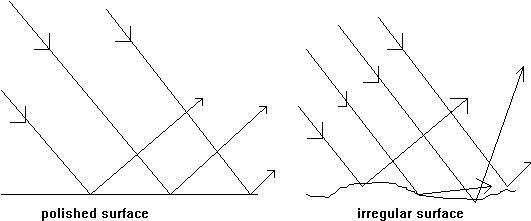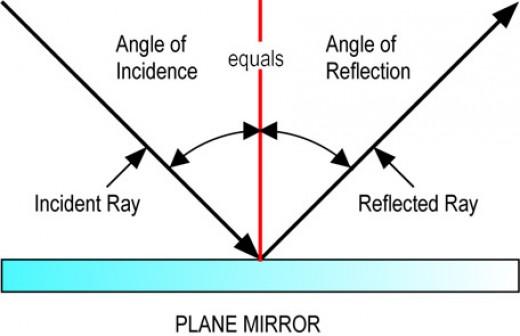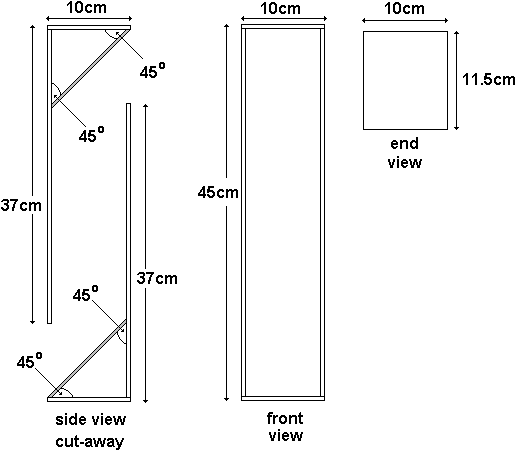Lesson Notes By Weeks and Term - Senior Secondary School 2
REFLECTION OF LIGHT ON PLANE SURFACE
SUBJECT: PHYSICS
CLASS:� SS 2
DATE:
TERM: 3rd TERM
REFERENCE TEXTBOOKS
�
�
WEEK ONE
TOPIC: REFLECTION OF LIGHT ON PLANE SURFACE
There are two types of reflection:

In regular reflection, parallel rays of light incident on a smooth or polished surface are reflected as parallel rays in one direction. In diffused or irregular reflection, parallel rays of light incident on a rough or irregular surface are reflected in various directions
LAWS OF REFLECTION
The first law of reflection states that the incident ray, the reflected ray and the normal at the point of incidence all lie in the same plane
The second law of reflection states that the angle of incidence (i) is equal to angle of reflection (r).

CHARACTERISTICS OF IMAGE FORMED BY PLANE MIRROR
�
IMAGE
There are two types of image:
�
A real image is one that can be caught on a screen.� Light rays actually pass through real image.� A virtual image is one that cannot be caught on a screen.� It is one through which rays do not actually pass but which is nevertheless visible to the eye.
�
LATERAL INVERSION
The effect on plane mirror on objects placed in front of it whereby the appearance of the image looks like a reversal of the object is known as lateral inversion

IMAGES FORMED BY INCLINED MIRROR
When two mirrors are placed at an angle to each other, the number of images formed is given by:
��� N = 360 �- 1
��� � � � � Ө
��� N = Number of images
Ө = Angle of inclination
When Ө = 1800, the two mirrors will act as a single mirror and therefore formed only one image.� When Ө = O, the two mirrors are parallel to each other and the image of object placed between them will be at infinity.
�
EFFECT OF MIRROR ROTATION ON REFLECTED RAY-MIRROR GALVANOMETER
If the direction of an incident ray on a mirror is kept constant and the mirror is rotated through twice that angle.� This fact is utilized in mirror galvanometer (to measure very small electric current) and in the navigators sextant.
�
EXAMPLE
The reflection of a narrow beam of light incident normally on a plane mirror falls on a metre rule parallel to the mirror and at a distance of 1m.� Calculate the angle of rotation of the mirror if the reflected beam is displaced 21.26cm along the metre-rule when the mirror rotated.
Angle ONP = 2 Ө
Tan 2 Ө = 21.26
��� � � 100
��� ��� = 0.2126
��� 2 Ө = tan-1 (0.2126)
��� 2 Ө = 120
��� � Ө = 60
EVALUATION
�
USES OF PLANE MIRROR
PERISCOPE

��� ���
General Revision
2 � A body is projected horizontally from the top of a tower with a velocity of 20m/s. It land on a ����level ground at a horizontal distance of 60m from the foot of the tower. Calculate the height of ����the tower.� [g= 10m/s2]
�
WEEKEND ASSIGNMENT
1�� Plane mirrors are used in all these except
2 �Two plane mirrors are placed touching and at 600 to each other. If an object is placed �����between the mirrors and viewed from above the mirrors. How many images will the eye �����see?
����(a) 5 images � (b) 6 images (c) 4 images (d) 3 images
3 ���When a ray of light is reflected from a plane surface, the angle of incidence is always equal ������to the angle of� ( a) reflection (b) refraction ( c ) diffraction (d) dispersion
4 ��Which of the following statements is untrue?
���When an image is formed in a plane mirror, the image formed will be
�� (a) the same size as the object(b) smaller than the object� (c) laterally inverted (d) always ����virtual
5 ��In which of the following instrument is the image that is formed erect
�
THEORY
1 What do you understand by the term lateral inversion?
2 Two plane mirrors inclining at an unknown angle, forms 11 images. Find the value of the angle?
�
READING ASSIGNMENT
New school physics for senior sec schools pages 278-285
� Lesson Notes All Rights Reserved 2023